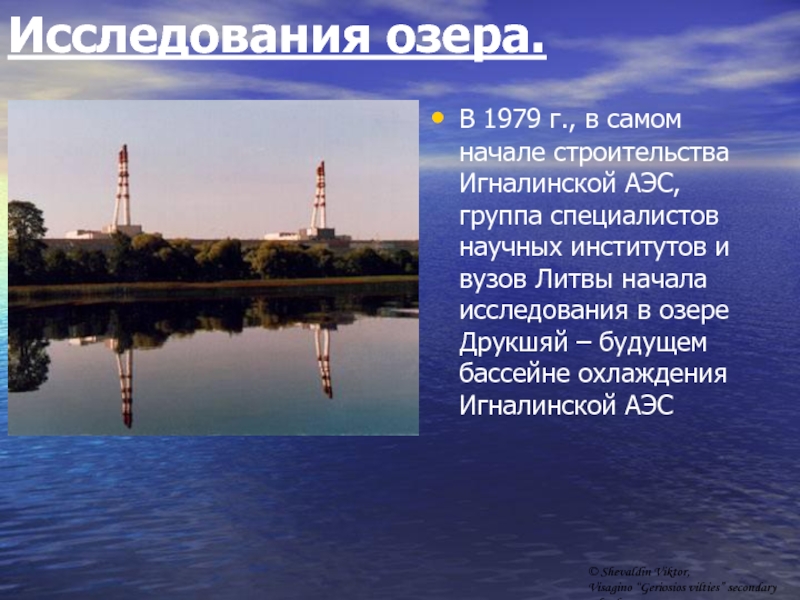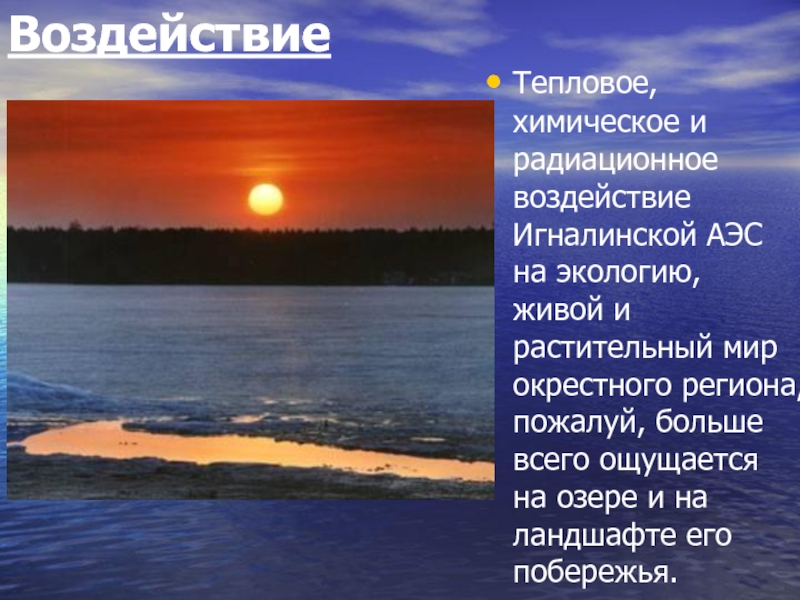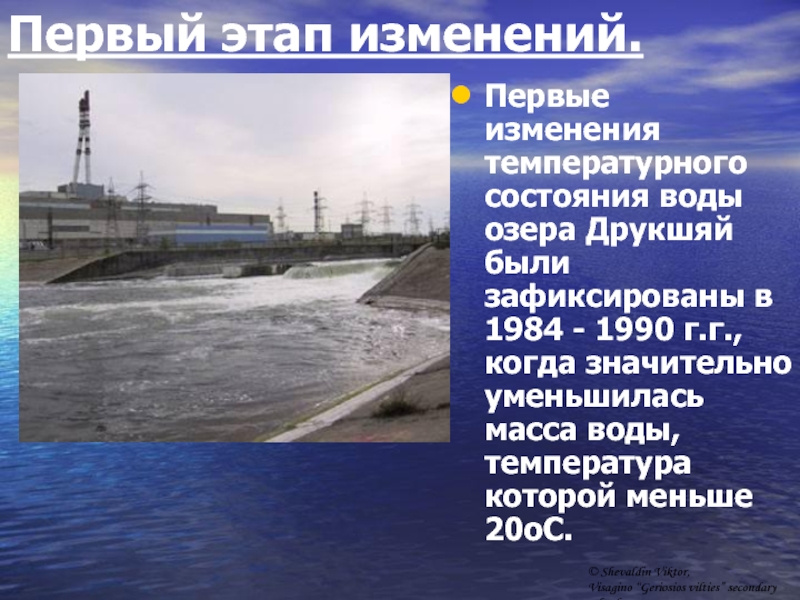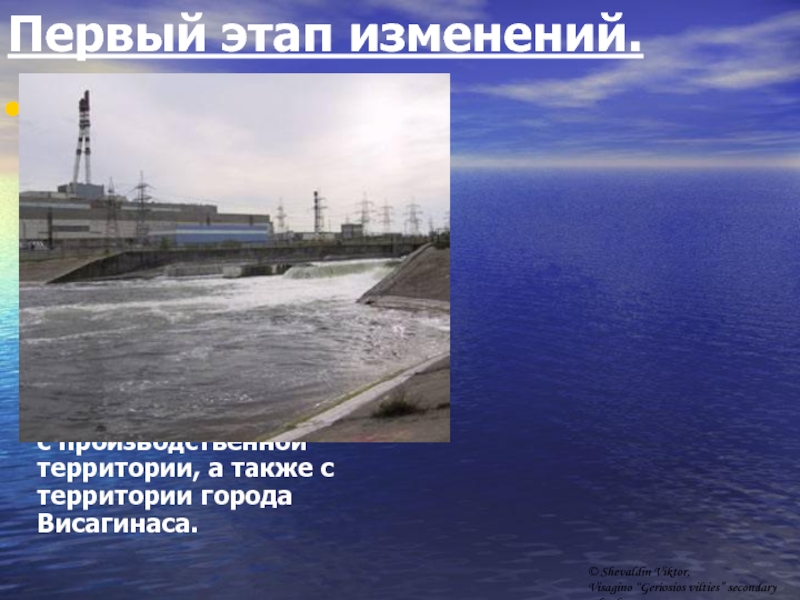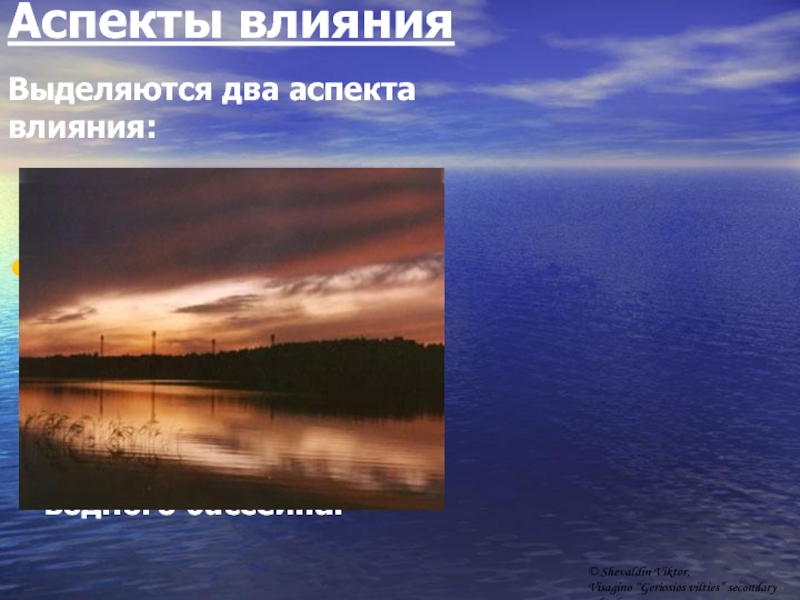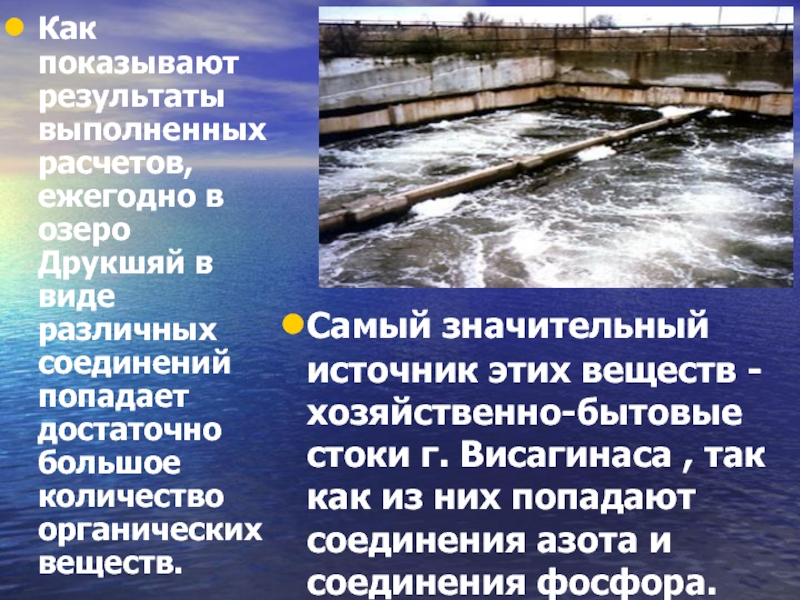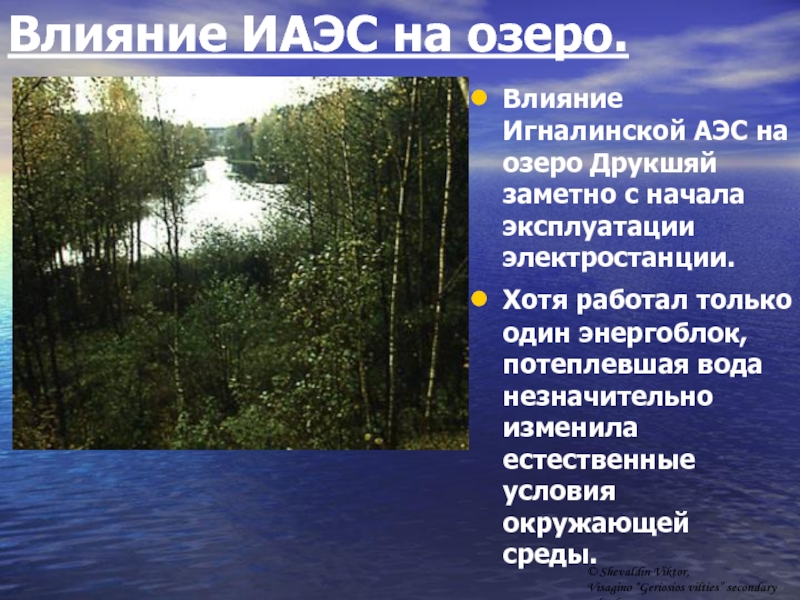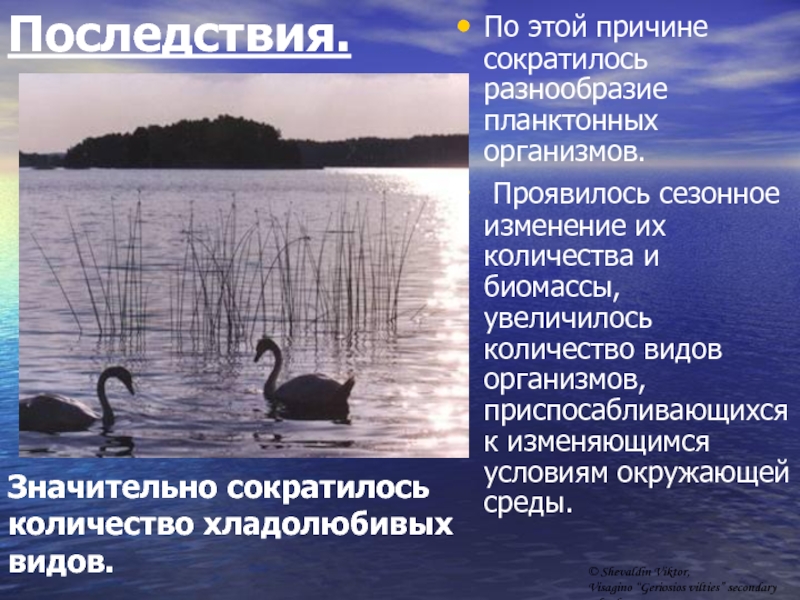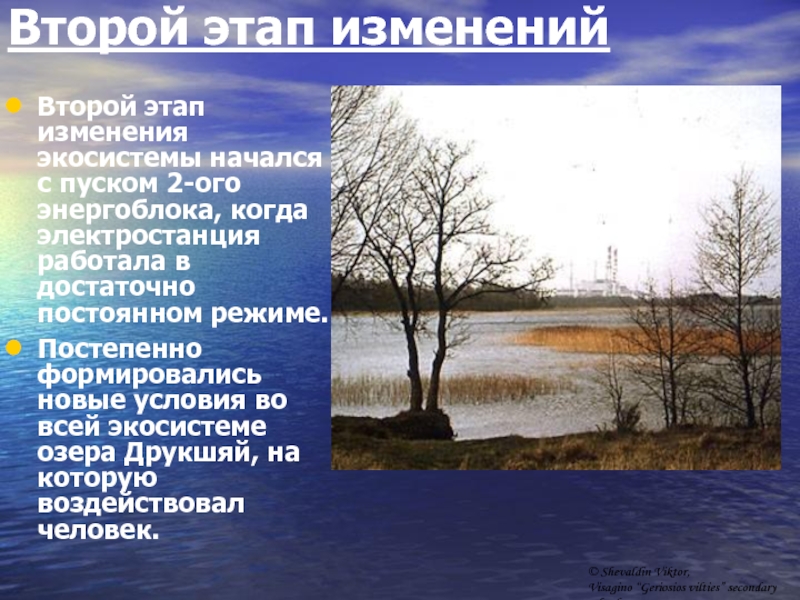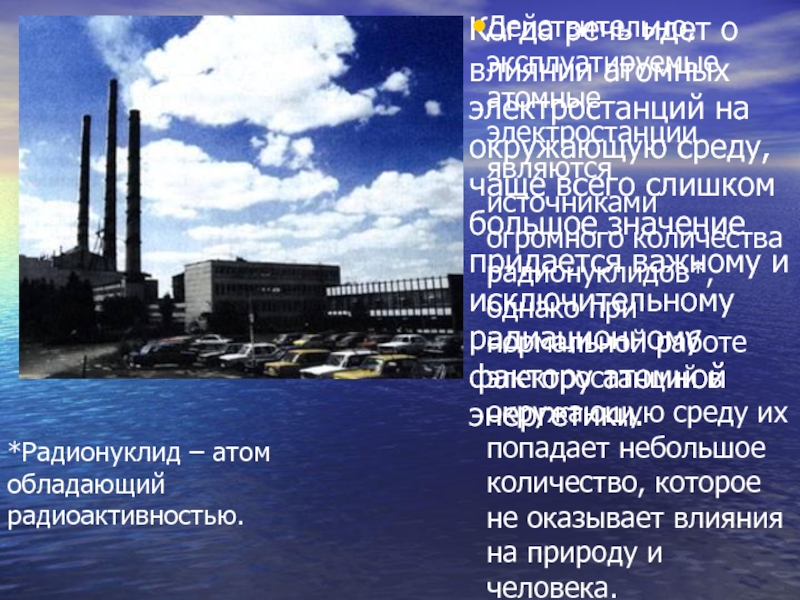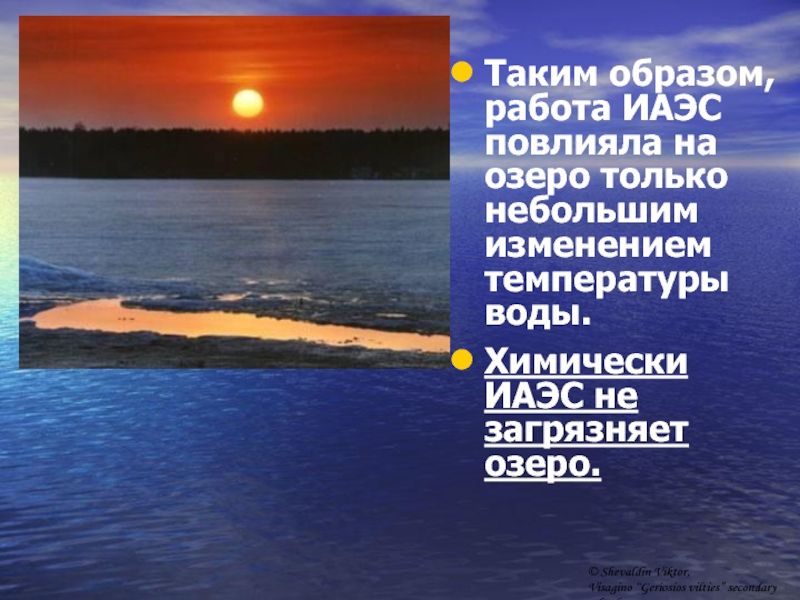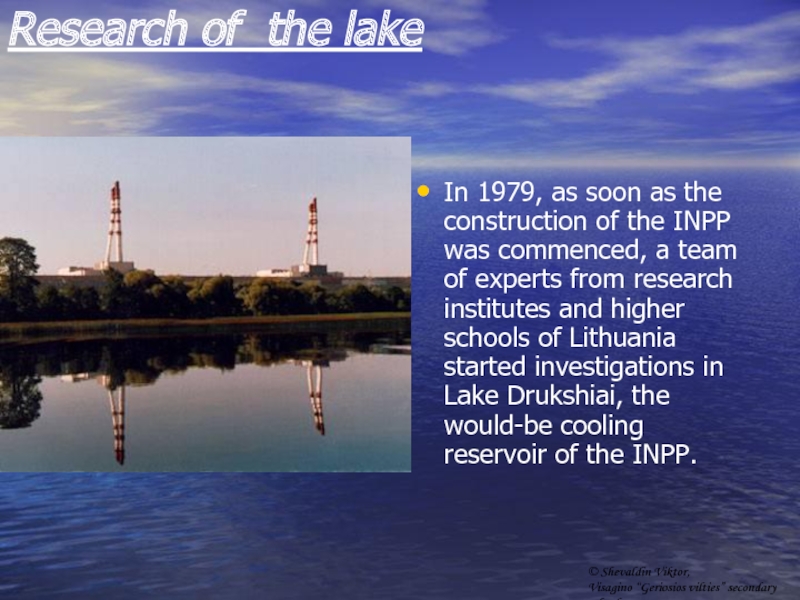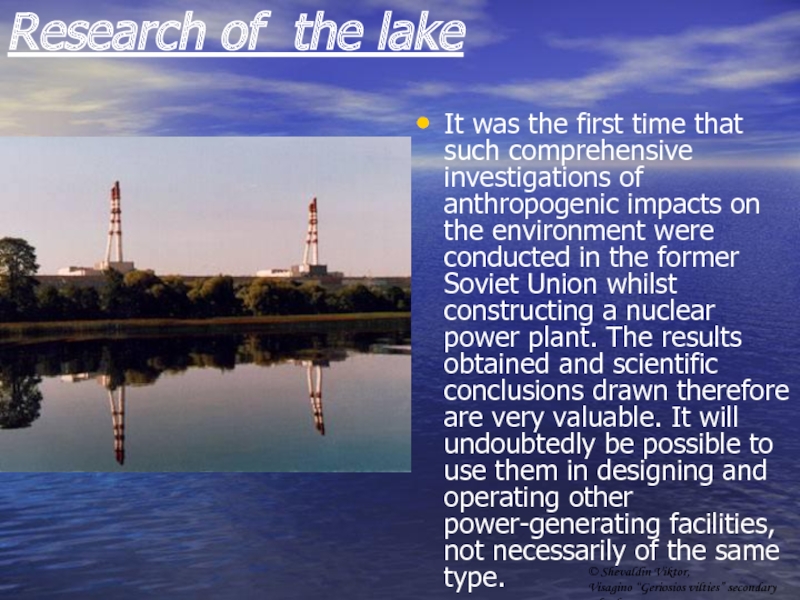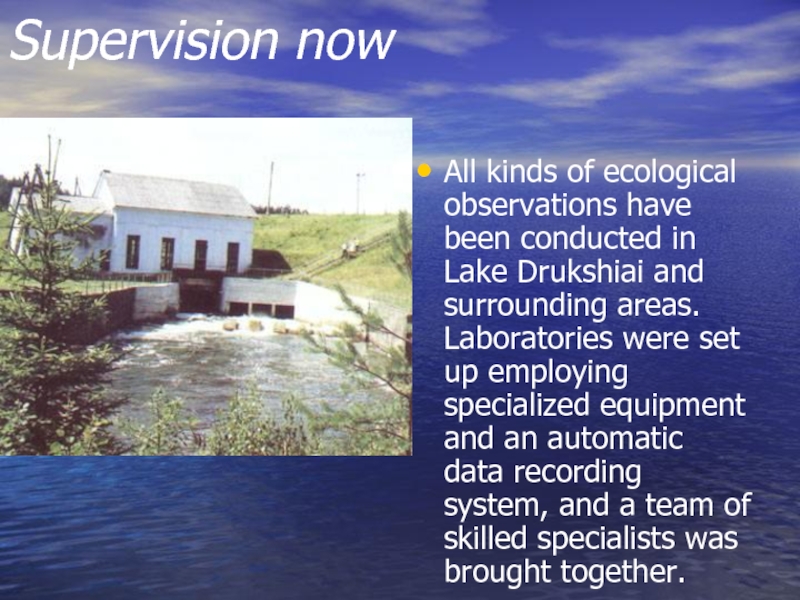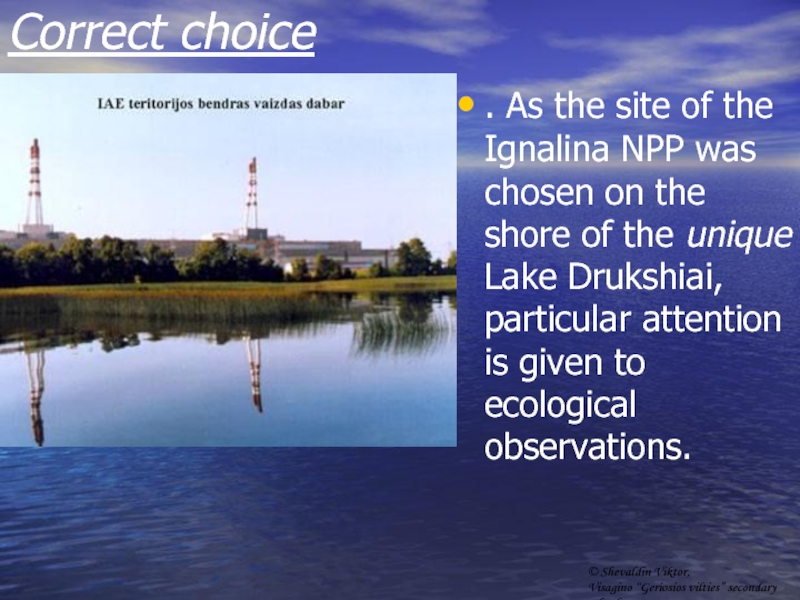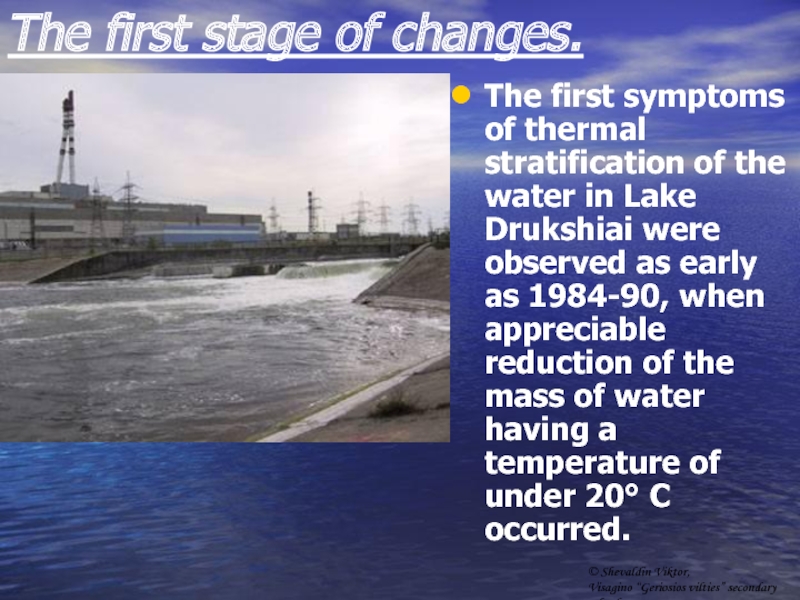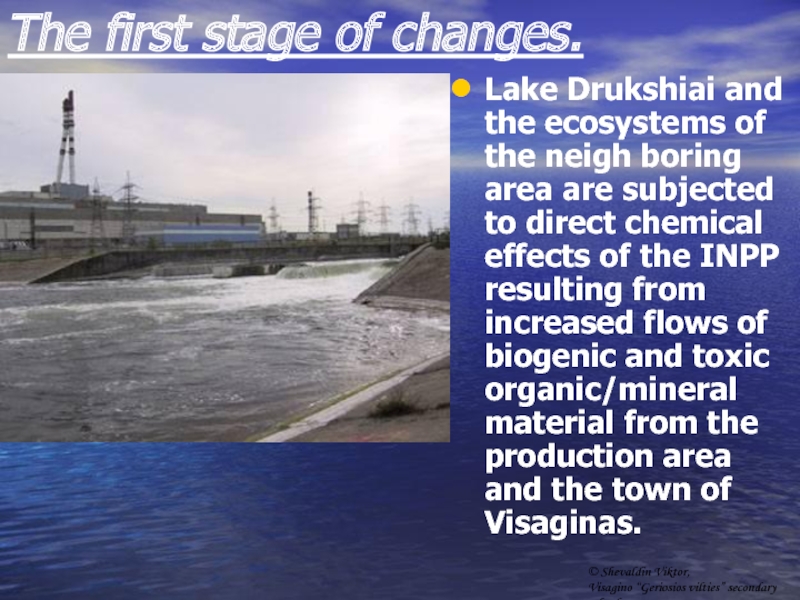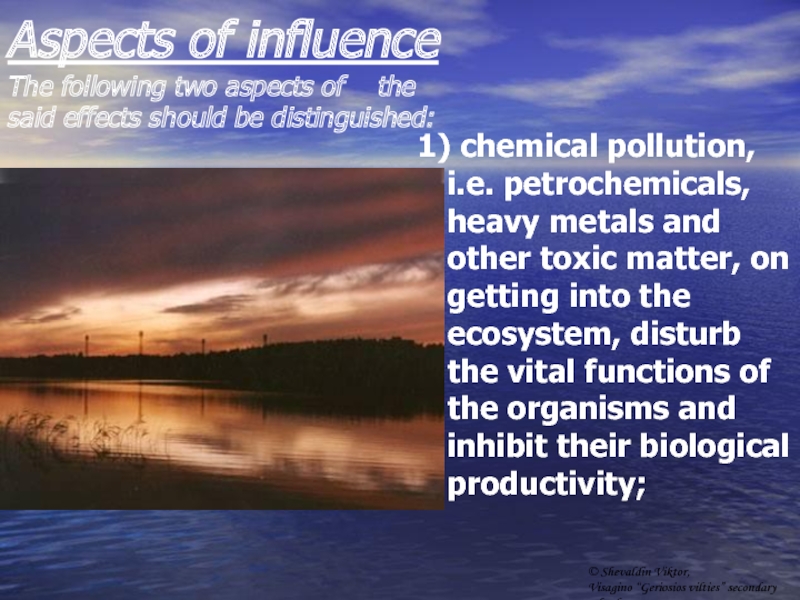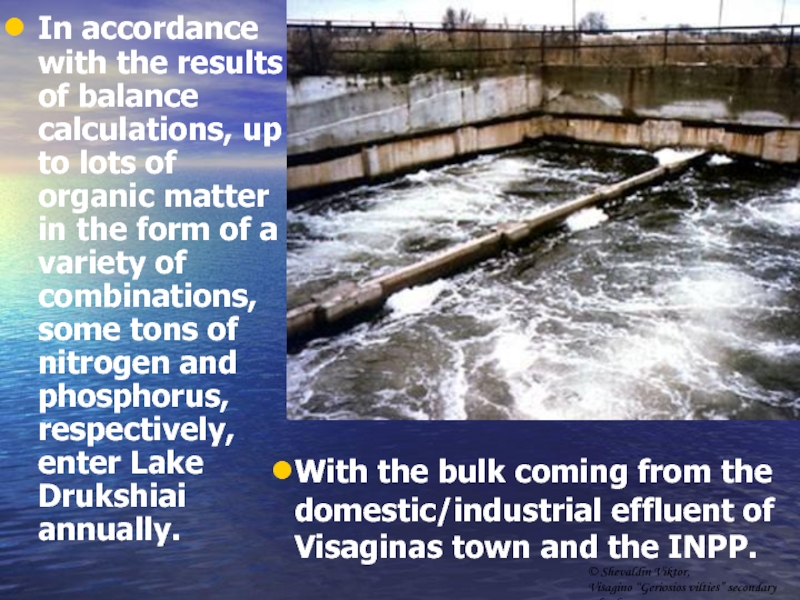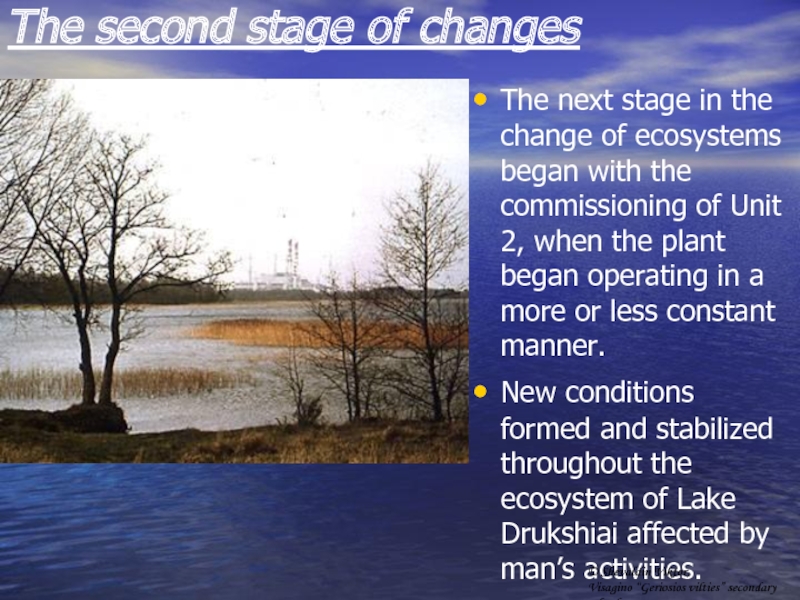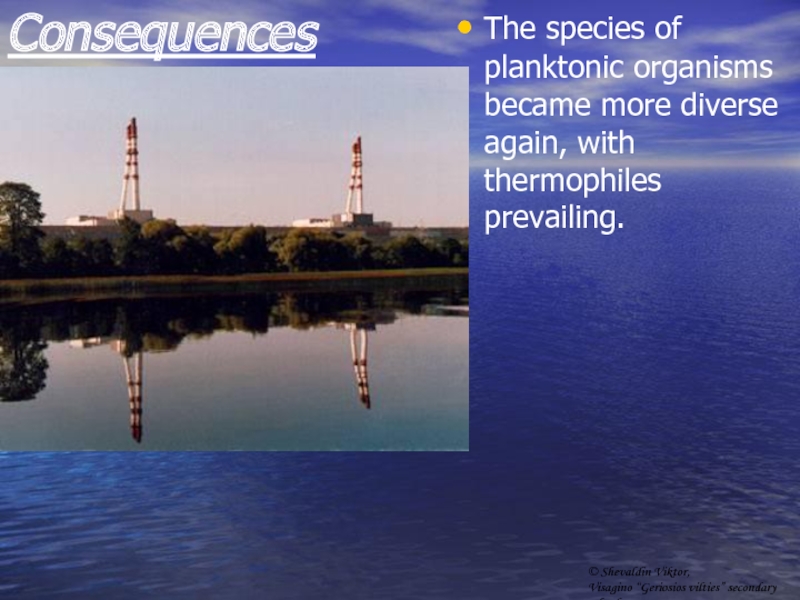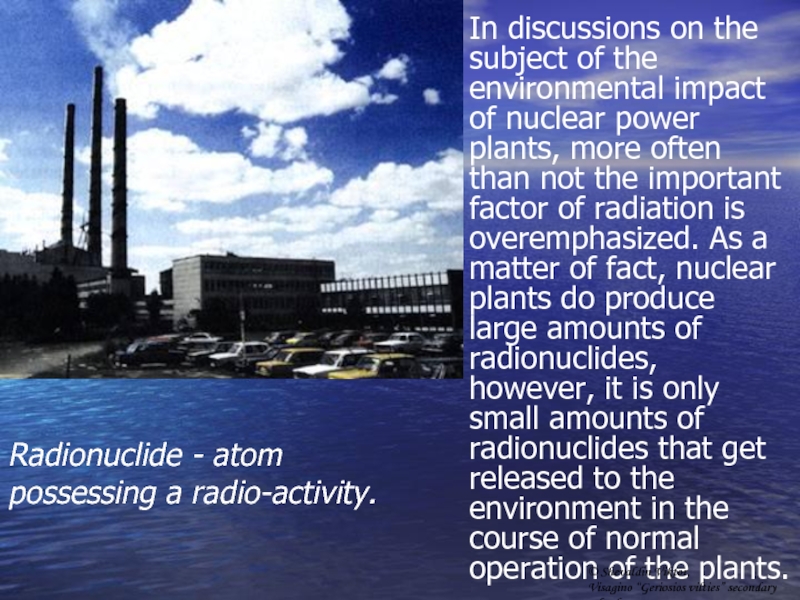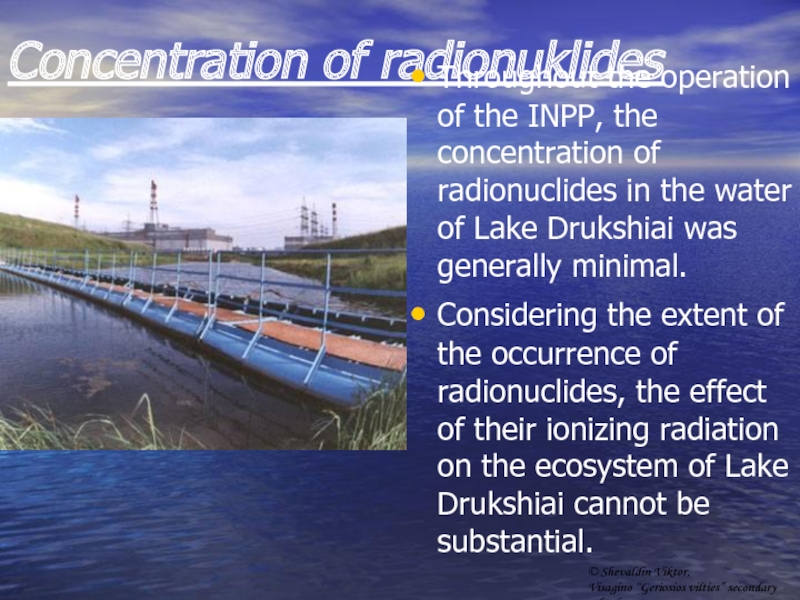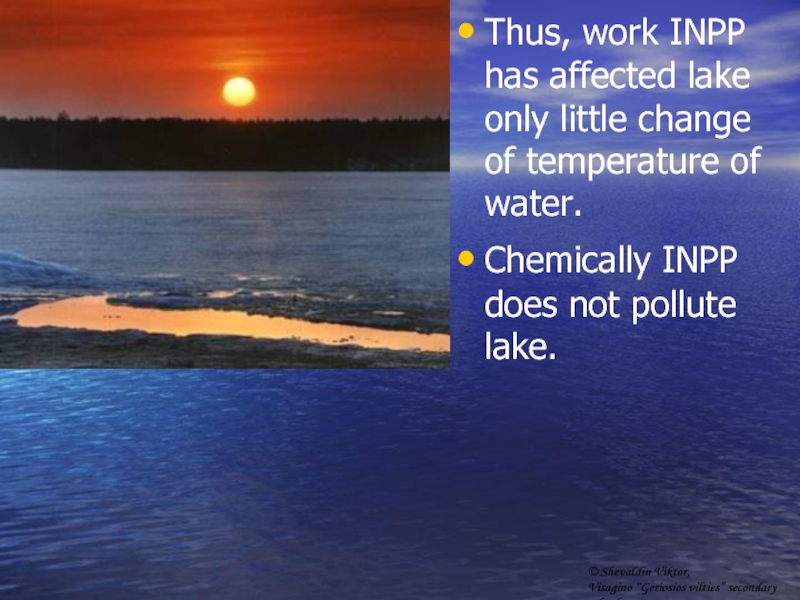- Главная
- Разное
- Дизайн
- Бизнес и предпринимательство
- Аналитика
- Образование
- Развлечения
- Красота и здоровье
- Финансы
- Государство
- Путешествия
- Спорт
- Недвижимость
- Армия
- Графика
- Культурология
- Еда и кулинария
- Лингвистика
- Английский язык
- Астрономия
- Алгебра
- Биология
- География
- Детские презентации
- Информатика
- История
- Литература
- Маркетинг
- Математика
- Медицина
- Менеджмент
- Музыка
- МХК
- Немецкий язык
- ОБЖ
- Обществознание
- Окружающий мир
- Педагогика
- Русский язык
- Технология
- Физика
- Философия
- Химия
- Шаблоны, картинки для презентаций
- Экология
- Экономика
- Юриспруденция
Select language презентация
Содержание
- 1. Select language
- 2. Влияние ИАЭС на озеро Друкшяй © Shevaldin Viktor, Visagino “Geriosios vilties” secondary school
- 3. Исследования озера. В 1979 г., в самом
- 4. Исследования озера. Первый раз в практике строительства
- 5. Наблюдения в настоящее время На озере Друкшяй
- 6. Правильный выбор Для Игналинской АЭС было подобрано
- 7. Воздействие Тепловое, химическое и радиационное воздействие Игналинской
- 8. Первый этап изменений. Первые изменения температурного состояния
- 9. Первый этап изменений. Непосредственное химическое влияние Игналинской
- 10. Аспекты влияния 1) химическое загрязнение,
- 11. Аспекты влияния 2) биогенные и
- 12. Как показывают результаты выполненных расчетов, ежегодно в
- 13. Влияние ИАЭС на озеро. Влияние Игналинской АЭС
- 14. Последствия. По этой причине сократилось разнообразие планктонных
- 15. Второй этап изменений Второй этап изменения экосистемы
- 16. Последствия. Вновь началось развитие видового разнообразия планктонных
- 17. Когда речь идет о влиянии атомных электростанций
- 18. Концентрация радионуклидов Концентрация радионуклидов в воде озера
- 19. Таким образом, работа ИАЭС повлияла на
- 20. С целью сохранения природы во многих странах
- 21. Источники информации Электронный выпуск, 2003 «ИАЭС. Информационная
- 22. Спасибо за
- 23. Выберите язык Select language © Shevaldin Viktor, Visagino “Geriosios vilties” secondary school
- 24. Influence of INPP on lake Drukshai © Shevaldin Viktor, Visagino “Geriosios vilties” secondary school
- 25. Research of the lake In
- 26. Research of the lake It
- 27. Supervision now All kinds of ecological observations
- 28. Correct choice . As the site of
- 29. Influence Thermal, chemical and radiation effects of
- 30. The first stage of changes. The first
- 31. The first stage of changes. Lake Drukshiai
- 32. Aspects of influence 1) chemical pollution, i.e.
- 33. Aspects of influence 2) improvement of nutrition
- 34. In accordance with the results of balance
- 35. Influence INPP on lake The first impacts
- 36. Consequences Planktonic organisms became less diverse, seasonal
- 37. The second stage of changes The next
- 38. Consequences The species of planktonic organisms became
- 39. In discussions on the subject of the
- 40. Concentration of radionuklides Throughout the operation of
- 41. Thus, work INPP has affected lake only
- 42. With the purpose of preservation of the
- 43. Sources of the information Electronic release, 2003
- 44. Thanks
Слайд 2Влияние ИАЭС на озеро Друкшяй
© Shevaldin Viktor,
Visagino “Geriosios vilties” secondary school
Слайд 3Исследования озера.
В 1979 г., в самом начале строительства Игналинской АЭС, группа
© Shevaldin Viktor,
Visagino “Geriosios vilties” secondary school
Слайд 4Исследования озера.
Первый раз в практике строительства атомной электростанции в бывшем Советском
Поэтому результаты исследований и выводы ученых - очень ценный материал и обоснованно может быть использован при проектировании или эксплуатации новой АЭС.
© Shevaldin Viktor,
Visagino “Geriosios vilties” secondary school
Слайд 5Наблюдения в настоящее время
На озере Друкшяй и в близлежащем регионе проводятся
© Shevaldin Viktor,
Visagino “Geriosios vilties” secondary school
Слайд 6Правильный выбор
Для Игналинской АЭС было подобрано место рядом с уникальным озером
© Shevaldin Viktor,
Visagino “Geriosios vilties” secondary school
Слайд 7Воздействие
Тепловое, химическое и радиационное воздействие Игналинской АЭС на экологию, живой
Слайд 8Первый этап изменений.
Первые изменения температурного состояния воды озера Друкшяй были зафиксированы
© Shevaldin Viktor,
Visagino “Geriosios vilties” secondary school
Слайд 9Первый этап изменений.
Непосредственное химическое влияние Игналинской АЭС на озеро Друкшяй и
© Shevaldin Viktor,
Visagino “Geriosios vilties” secondary school
Слайд 10Аспекты влияния
1) химическое загрязнение, когда попавшие в экосистему нефтепродукты, тяжелые
Выделяются два аспекта влияния:
© Shevaldin Viktor,
Visagino “Geriosios vilties” secondary school
Слайд 11Аспекты влияния
2) биогенные и органические вещества стимулируют улучшение условий пропитания водного
Выделяются два аспекта влияния:
© Shevaldin Viktor,
Visagino “Geriosios vilties” secondary school
Слайд 12Как показывают результаты выполненных расчетов, ежегодно в озеро Друкшяй в виде
Самый значительный источник этих веществ - хозяйственно-бытовые стоки г. Висагинаса , так как из них попадают соединения азота и соединения фосфора.
Слайд 13Влияние ИАЭС на озеро.
Влияние Игналинской АЭС на озеро Друкшяй заметно с
Хотя работал только один энергоблок, потеплевшая вода незначительно изменила естественные условия окружающей среды.
© Shevaldin Viktor,
Visagino “Geriosios vilties” secondary school
Слайд 14Последствия.
По этой причине сократилось разнообразие планктонных организмов.
Проявилось сезонное изменение их
Значительно сократилось количество хладолюбивых видов.
© Shevaldin Viktor,
Visagino “Geriosios vilties” secondary school
Слайд 15Второй этап изменений
Второй этап изменения экосистемы начался с пуском 2-ого энергоблока,
Постепенно формировались новые условия во всей экосистеме озера Друкшяй, на которую воздействовал человек.
© Shevaldin Viktor,
Visagino “Geriosios vilties” secondary school
Слайд 16Последствия.
Вновь началось развитие видового разнообразия планктонных организмов, однако преобладали теплолюбивые виды
© Shevaldin Viktor,
Visagino “Geriosios vilties” secondary school
Слайд 17Когда речь идет о влиянии атомных электростанций на окружающую среду, чаще
*Радионуклид – атом обладающий радиоактивностью.
Действительно, эксплуатируемые атомные электростанции являются источниками огромного количества радионуклидов*, однако при нормальной работе электростанций в окружающую среду их попадает небольшое количество, которое не оказывает влияния на природу и человека.
Слайд 18Концентрация радионуклидов
Концентрация радионуклидов в воде озера за весь период эксплуатации Игналинской
Судя по масштабу распространения радионуклидов, воздействие их ионизирующего излучения на экосистему озера Друкшяй не является существенным.
© Shevaldin Viktor,
Visagino “Geriosios vilties” secondary school
Слайд 19
Таким образом, работа ИАЭС повлияла на озеро только небольшим изменением температуры
Химически ИАЭС не загрязняет озеро.
© Shevaldin Viktor,
Visagino “Geriosios vilties” secondary school
Слайд 20С целью сохранения природы во многих странах приняты законы запрещающие использовать
© Shevaldin Viktor,
Visagino “Geriosios vilties” secondary school
Слайд 21Источники информации
Электронный выпуск, 2003 «ИАЭС. Информационная система»
© Shevaldin Viktor,
Visagino “Geriosios
Слайд 23
Выберите язык
Select language
© Shevaldin Viktor,
Visagino “Geriosios vilties” secondary school
Слайд 24Influence of INPP on lake Drukshai
© Shevaldin Viktor,
Visagino “Geriosios vilties” secondary
Слайд 25Research of the lake
In 1979, as soon as the construction
© Shevaldin Viktor,
Visagino “Geriosios vilties” secondary school
Слайд 26Research of the lake
It was the first time that such
© Shevaldin Viktor,
Visagino “Geriosios vilties” secondary school
Слайд 27Supervision now
All kinds of ecological observations have been conducted in Lake
Слайд 28Correct choice
. As the site of the Ignalina NPP was chosen
© Shevaldin Viktor,
Visagino “Geriosios vilties” secondary school
Слайд 29Influence
Thermal, chemical and radiation effects of the INPP on the ecosystems
© Shevaldin Viktor,
Visagino “Geriosios vilties” secondary school
Слайд 30The first stage of changes.
The first symptoms of thermal stratification of
© Shevaldin Viktor,
Visagino “Geriosios vilties” secondary school
Слайд 31The first stage of changes.
Lake Drukshiai and the ecosystems of the
© Shevaldin Viktor,
Visagino “Geriosios vilties” secondary school
Слайд 32Aspects of influence
1) chemical pollution, i.e. petrochemicals, heavy metals and other
The following two aspects of the said effects should be distinguished:
© Shevaldin Viktor,
Visagino “Geriosios vilties” secondary school
Слайд 33Aspects of influence
2) improvement of nutrition conditions in the body of
The following two aspects of the said effects should be distinguished:
© Shevaldin Viktor,
Visagino “Geriosios vilties” secondary school
Слайд 34In accordance with the results of balance calculations, up to lots
With the bulk coming from the domestic/industrial effluent of Visaginas town and the INPP.
© Shevaldin Viktor,
Visagino “Geriosios vilties” secondary school
Слайд 35Influence INPP on lake
The first impacts of the INPP on Lake
Слайд 36Consequences
Planktonic organisms became less diverse, seasonal changes became evident in their
© Shevaldin Viktor,
Visagino “Geriosios vilties” secondary school
Слайд 37The second stage of changes
The next stage in the change of
New conditions formed and stabilized throughout the ecosystem of Lake Drukshiai affected by man’s activities.
© Shevaldin Viktor,
Visagino “Geriosios vilties” secondary school
Слайд 38Consequences
The species of planktonic organisms became more diverse again, with thermophiles
© Shevaldin Viktor,
Visagino “Geriosios vilties” secondary school
Слайд 39In discussions on the subject of the environmental impact of nuclear
Radionuclide - atom possessing a radio-activity.
© Shevaldin Viktor,
Visagino “Geriosios vilties” secondary school
Слайд 40Concentration of radionuklides
Throughout the operation of the INPP, the concentration of
Considering the extent of the occurrence of radionuclides, the effect of their ionizing radiation on the ecosystem of Lake Drukshiai cannot be substantial.
© Shevaldin Viktor,
Visagino “Geriosios vilties” secondary school
Слайд 41Thus, work INPP has affected lake only little change of temperature
Chemically INPP does not pollute lake.
© Shevaldin Viktor,
Visagino “Geriosios vilties” secondary school
Слайд 42With the purpose of preservation of the nature in many countries
© Shevaldin Viktor,
Visagino “Geriosios vilties” secondary school
Слайд 43Sources of the information
Electronic release, 2003 « INPP. Information system »
©
Visagino “Geriosios vilties” secondary school


